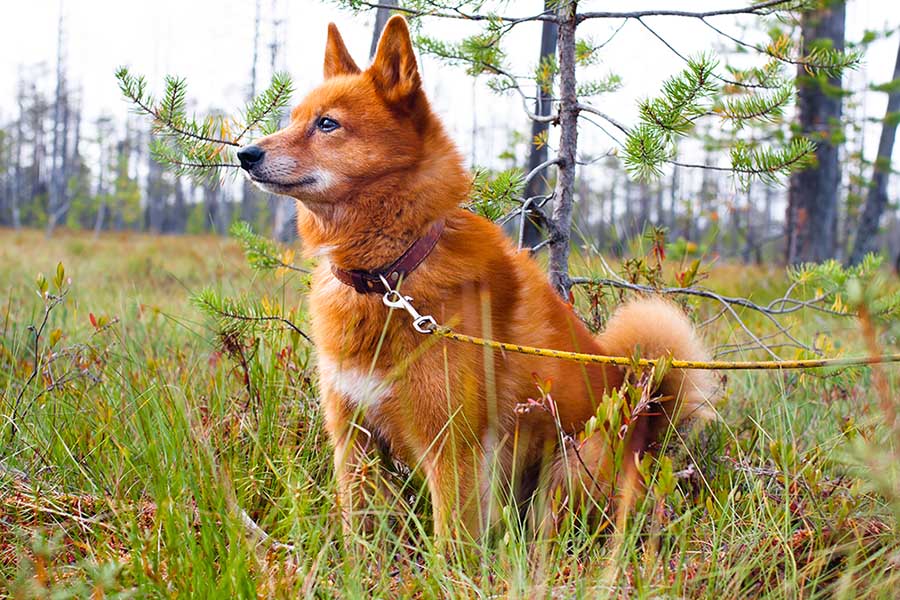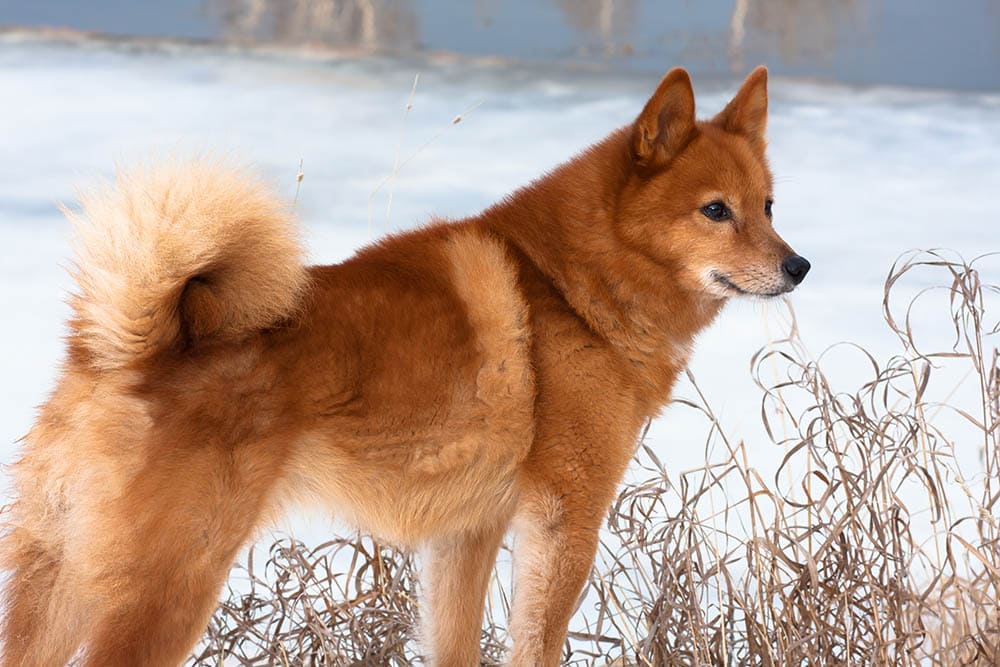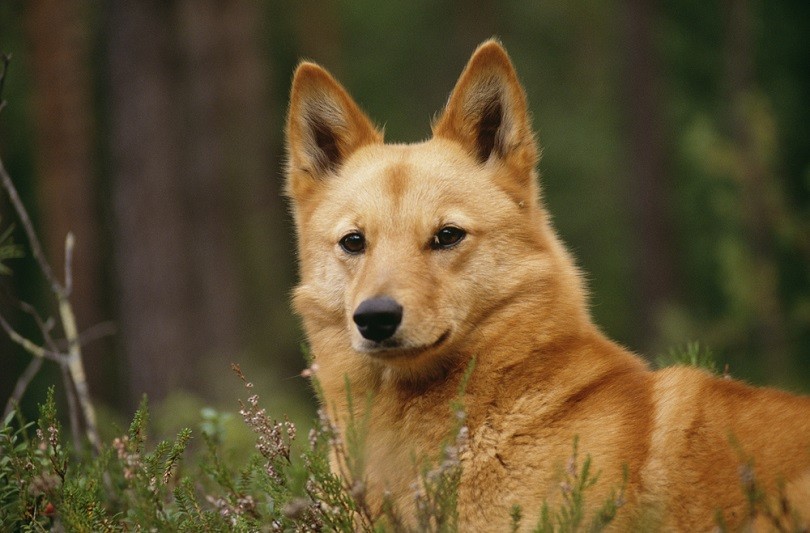
Click Below to Skip Ahead
The Finnish Spitz is a purebred dog that originated in Finland as a small game hunter. It’s particularly good at pointing to game that is hiding in shrubbery so human hunters can find it. It’s a popular house pet due to its small size, which allows it to thrive in an apartment setting and its happy, friendly temperament makes it all the more fun to be around.
Breed Overview
Height:
15 – 20 inches
Weight:
16 – 33 pounds
Lifespan:
12 – 15 years
Colors:
Red, gold, white
Suitable for:
Apartments, single owners, families
Temperament:
Vocal, happy, independent, intelligent
If you are thinking of getting one of these dogs for your home but would like to learn more about it first, keep reading while we look at cost, training, temperament, health risks, and more to help you make an informed decision.
Finnish Spitz Characteristics
Finnish Spitz Puppies
Since these dogs are not as popular as some other breeds, it can be challenging to find one near you, and transportation costs can play a factor. If you want to breed the dogs for private or commercial gain, you will need to purchase breeding rights, which can be quite expensive. If you don’t purchase breeding rights, you will likely need to get the puppy spayed or neutered. Some breeders also charge more for a competition-quality dog than a pet quality, so you will need to pay extra if you intend to enter your dog into puppy shows.
You will also need to purchase food, toys, and treats for your dog, and it will need regular checkups at the vet, as well as flea and tick medication, which will increase the overall cost of your pet.
Temperament & Intelligence of the Finnish Spitz
The Finnish Spitz is a lively dog that’s fast and agile. It likes to run with all its got and feels especially at home in the snow. It prefers having something to do rather than lounging around and can quickly become bored and even destructive. It’s cautious around new people but will make friends quickly, and it’s a great dog to take walking on a trail. It enjoys being around people and will alert you to any danger by barking and pointing, which it does by standing in a specific way and facing in the direction of the perceived threat.
The Finnish Spitz is an intelligent breed that will have no problem learning several tricks. The problem is that it can quickly lose focus as it barks at every little noise it hears and will often wander off in pursuit of its distraction. It can also be a little stubborn, so it’s better suited to someone with experience dealing with difficult dogs.
Are These Dogs Good for Families? 👪
The Finnish Spitz makes an excellent companion on the walking trail and is well suited for both small apartments and large homes. Since it has so much energy, children can be extremely helpful for burning off that excess energy, so the dog doesn’t become bored and destructive. Children like to play games and run around as much as your dog does, so they are a good combination. The Finnish Spitz also makes an excellent watchdog because it barks at any sound. However, continuous barking can be a problem in some homes.

Does This Breed Get Along with Other Pets?
The Finnish Spitz usually gets along with larger dog breeds, but it can sometimes bark and chase after smaller animals due to its hunting instincts. Early socialization can help it get along with your current pets, including cats, but it will still be likely to chase after rabbits and squirrels in your yard. It might also chase after other pets you introduce into the family later.
Things to Know When Owning a Finnish Spitz:
Food & Diet Requirements 🦴
Your Finnish Spitz is an active dog that will require plenty of protein to stay healthy and develop strong muscles. To ensure your pet gets enough protein, we recommend choosing a brand with real meat listed as its first ingredient. Chicken, turkey, lamb, and beef are all great choices that will help keep your dog healthy, while other ingredients, like corn and soy, are mostly empty calories and will not provide your dog with the nutrition it requires. We also recommend avoiding chemical preservatives and artificial colors.

Exercise 🐕
Your Finnish Spitz will require plenty of exercise, and we recommend setting aside at least one hour per day for vigorous activity. Games that require plenty of running are best. Fetch, and frisbee will keep your pet running and will burn off the excess energy faster. Children can also help because they like to run and play games and often do all of the work for you, especially if you have a few children.
Training 🎾
As we mentioned earlier, your Finnish Spitz is extremely intelligent and can learn many tricks, even complex ones. The challenge is keeping your pet focused long enough to understand what you are trying to show it. We recommend setting up short training sessions at the same time each day, preferably soon after exercise, so it is tired and ready to focus. Holding the sessions at the same time each night will help your dog get into a routine that will help your dog arrive prepared to learn.
Grooming ✂️
The Finnish Spitz has a thick double coat that will require plenty of brushing. We recommend brushing your dog twice per week for most of the year and daily during the shedding seasons of spring and fall. It will rarely need a bath, and we recommend only giving it one when it gets into something that warrants it. Occasional grooming from a professional can help keep your dog looking its best. Manually brushing your pet’s teeth can help slow the progression of dental disease, and you may also need to trim the nails if it spends most of its time in the house.
Health and Conditions 🏥
Serious Conditions
Minor Conditions
Male vs Female
The male Finnish Spitz is noticeably larger than the female, and it’s easy to tell the difference even from a distance. However, there is no difference between the sexes when it comes to temperament or behavior, and this is even more true if you have your Finnish Spitz spayed or neutered.
3 Little-Known Facts about the Finnish Spitz
1. The Finnish Spitz is the best-known dog breed from Finland.
2. You can also call a Finnish Spitz a Barking Bird Dog, Finnish Hunting Dog, Finky, and many other names.
3. Despite possibly being thousands of years old, the American Kennel Club didn’t recognize the Finnish Spitz until 1988.
Final Thoughts
The Finnish Spitz is an active dog that makes a fantastic pet. It’s better suited to larger families due to its high energy level and experienced owners that can train hard-to-focus dogs. However, if you’re prepared to give your dog plenty of attention and live an active lifestyle, the Finnish Spitz can also be suitable for beginners. It gets along well with children but may chase after smaller animals, and some people don’t like that it likes to bark a lot.
We hope you have enjoyed reading over this guide and found it helpful in answering your questions. If we have convinced you to get one of these dogs for your home, please share this guide to the Finnish Spitz temperament and traits on Facebook and Twitter.
Related Read:
Featured Image Credit: rodimov, Shutterstock









